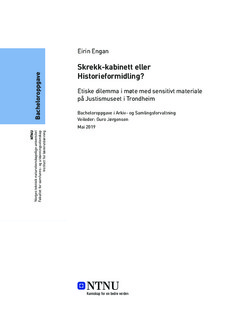| dc.contributor.advisor | Jørgensen, Guro | |
| dc.contributor.author | Engan, Eirin | |
| dc.date.accessioned | 2019-08-23T14:08:19Z | |
| dc.date.available | 2019-08-23T14:08:19Z | |
| dc.date.issued | 2019 | |
| dc.identifier.uri | http://hdl.handle.net/11250/2610352 | |
| dc.description.abstract | På Justismuseet i Trondheim står det utstilt en hodeskalle. Hodeskallen stammer trolig fra 1700-tallet, og ble gravd opp i 1941. Den stammer fra en person som ble henrettet. Personen fikk hodet kappet av og skallen spikret på en påle. Straffen var ment som en skamstraff, både for den avdøde og dens familie, og straffen skulle vare inn i etterlivet. Denne hodeskallen er utgangspunktet for mitt studie av sensitiv informasjon på museum, og etikk i museumsverdenen.
For å skaffe empiri har jeg intervjuet tre personer på museet: Anna, som er formidlingsansvarlig, Even, som skal utgi podkast om funnene de har gjort i skriftlige kilder om hodeskallen, og Roar, som er rådgiver på museet og den som anskaffet hodeskallen. Jeg har også intervjuet ni av de besøkende på museet for å finne ut hva de tenker om sensitive gjenstander på museum. For å se på det teoretiske grunnlaget har jeg tatt utgangspunkt i ICOMs (International Council of Museums) museumsetiske regelverk.
Hodeskallen slik den står i dag mangler historie, men museet har startet undersøkelser av skriftlige kilder for å finne ut mer. Når hodeskallen får mer historie og kontekst rundt seg, så går hodeskallen fra å være en rekvisitt til å bli et museumsobjekt, og de ansatte må ta stilling til hvordan de skal forholde seg til den sensitive informasjonen som kommer med undersøkelsen. De er enige om at kontekst gir mer verdighet til den avdøde, men er ikke enige om historien blir for sterk for de besøkende.
I utstillingen står hodeskallen utstilt på toppen av en vertikal glasspinne, som symboliser en påle. En av de ansatte føler at straffen som den avdøde en gang mottok, fortsatt foregår i dag, og at avstraffelsen fremdeles er i gang. En annen av de ansatte føler at glasspinnen er et godt symbol på historien, og historien de på museet vil fortelle i dag.
Guiden spiller en viktig rolle på museet for å få frem den ønskede historien til de besøkende. De ansatte er redde for at uten en god formidler så kan utstillingen blir sett på som ett skrekkkabinett, og det er ikke den historien de ønsker å formidle. De fleste besøkende jeg intervjuet var veldig historiebevisste og brukte utstillingen slik den var ment, til å dra linjer frem til i dag for å lære noe av dagens samfunn. De ansatte sier de at de ikke får noen reaksjoner fra de besøkende på hodeskallen alene, men de melder om at besøkende har svimt av under formidlinger. Guiden bestemmer hvor sterk historie en gjenstand skal ha, og hvordan man vinkler den, og hvordan museets stemme utad er. | |
| dc.description.abstract | At the Museum of Justice in Trondheim, there is an exhibition with a skull. This skull is from the 1700s, and was dug up in 1941. It belonged to a person that was executed. That person got beheaded and the skull was nailed to a pole. The punishment was meant as a shame, both to the deceased and to their family, and was meant to last for all eternity.
I have interviewed three employees at the museum to get empirical data: Anna, which is the Head of Public Outreach and Exhibitions, Even, who is studying written sources about the skull, and is publishing the material in a podcast, and Roar, who is an adviser at the museum, and the one who acquired the skull for the museum. I have also interviewed nine of the visitors at the museum to find out what they think about sensitive objects at the museum. I have based the theoretical foundation on ICOM’s (International Code of Museums) Code of Ethics for Museums.
The skull is missing critical parts of its history today, but the museum has started to examine old written sources to discover more. The skull will go from being just a prop to becoming a museum object when we know more about its history and its context, and the employees at the museum has to decide how to proceed when they get the sensitive information that comes with the examination. They agree that the context gives more dignity to the deceased, but can’t quite agree whether the history is too brutal for the visitors.
The skull is mounted on top of a pole in the exhibition. One of the employees feels that the deceased still receives the same punishment as when the person first died, while another one feel that the pole is a good symbol of the history and the story the employees tell today.
The role of a guide is important to the museum to get the right message through to the visitors. The employees are afraid that the exhibition could be viewed as horror and entertainment by the visitors without a good guide, which is not the story they want to tell the public. Most visitors that I have interviewed was very conscious about what history tells us, and uses the exhibition the way it was meant to; to use the information to learn something about society today. The employees say that they don’t get any reactions from the visitors that visits the exhibition with the skull, but at the same time they say that some visitors faint when they get to know the information behind the exhibition and the items there. The guide decides how strong the history of an item is, which point of view it should be told from, and what voice the museum wants to portray to the public. | |
| dc.language | nob | |
| dc.publisher | NTNU | |
| dc.title | Skrekk-kabinett eller Historieformidling? Etiske dilemma i møte med sensitivt materiale på Justismuseet i Trondheim | |
| dc.type | Bachelor thesis | |
